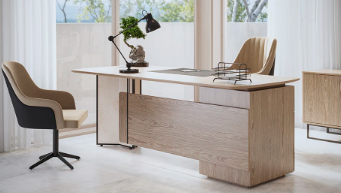Incorporating Office Desks into Green and Sustainable Office Design

Sustainability has become a central focus in modern office design, with businesses increasingly adopting eco-friendly practices. Incorporating office desks into a green and sustainable design can significantly reduce environmental impact while creating a healthier and more inspiring workplace. Here’s how to achieve this balance effectively.
1. Choosing Eco-Friendly Materials
Office desks made from sustainable materials are a cornerstone of green office design. Look for desks crafted from responsibly sourced wood, bamboo, or recycled materials. These options reduce deforestation and waste while offering durability and aesthetic appeal. Certifications such as FSC (Forest Stewardship Council) or PEFC (Programme for the Endorsement of Forest Certification) indicate environmentally responsible production.
Recycled metal or reclaimed wood desks are also excellent choices. Not only do these materials reduce the demand for virgin resources, but they also add a unique character to the workspace, reflecting a commitment to sustainability.
2. Prioritising Durability and Longevity
High-quality office desks designed for longevity minimise waste by reducing the need for frequent replacements. Durable desks, paired with other robust office furniture, ensure the workspace remains functional and visually appealing for years to come. Opt for desks with modular components that can be repaired or updated instead of discarded, further extending their lifecycle.
3. Promoting Ergonomic Sustainability
Ergonomic office desks contribute to employee well-being and sustainability by reducing the need for medical interventions related to poor posture or repetitive strain injuries. Adjustable desks, including sit-stand options, cater to various working styles and body types, making them a sustainable choice for diverse workplaces.
These desks not only enhance comfort but also encourage healthier work habits, leading to improved productivity and reduced absenteeism. When paired with ergonomic office chairs, the overall workspace becomes both sustainable and employee-centric.
4. Sourcing Locally
Purchasing office desks and furniture from local manufacturers reduces the carbon footprint associated with transportation. Supporting local businesses also boosts the regional economy and fosters community connections. When sourcing desks, consider suppliers who prioritise sustainable practices in their production processes and use eco-friendly packaging.
5. Integrating Renewable Energy Features
Modern office desks can be equipped with built-in features that support renewable energy use. For example, desks with integrated solar-powered charging stations or energy-efficient lighting reduce reliance on non-renewable resources. These features align with a company’s green initiatives while offering practical benefits for employees.
6. Designing for Space Optimisation
Maximising space efficiency is a vital aspect of sustainable office design. Compact and multi-functional desks allow businesses to make the most of their available area, reducing the need for excessive furniture. Desks with built-in storage solutions, such as shelves or compartments, eliminate the need for additional cabinets, further minimising material usage.
Open-plan designs that incorporate shared desks or hot-desking arrangements also optimise space usage, accommodating more employees with fewer resources.
7. Incorporating Recycled Office Furniture
Integrating recycled or refurbished office furniture is an effective way to reduce waste while maintaining functionality and style. Many refurbished desks are restored to near-new condition, offering an affordable and eco-friendly alternative to buying brand-new pieces. By embracing a circular economy approach, businesses demonstrate a commitment to reducing landfill contributions.
8. Enhancing Indoor Air Quality with Sustainable Desks
Some conventional office desks are made with materials that release volatile organic compounds (VOCs), which can harm indoor air quality. Choosing desks made from low-VOC or non-toxic materials enhances air quality, promoting a healthier workspace. Pairing these desks with indoor plants can further purify the air, creating a calming and eco-conscious environment.
9. Encouraging Employee Involvement
Involving employees in sustainable office design fosters a culture of environmental responsibility. Offer options for customising desk setups with sustainable accessories, such as reusable desk organisers, bamboo monitor stands, or recycled paper products. This personalisation allows employees to take ownership of their workspace while reinforcing the company’s commitment to sustainability.
10. Combining Aesthetics with Sustainability
Sustainable office design does not mean sacrificing style. Many eco-friendly office desks combine sleek designs with sustainable materials, creating a visually appealing workspace. The right choice of office furniture enhances the overall aesthetic while communicating the organisation’s dedication to green practices.
Balancing Functionality and Environmental Impact
Creating a green and sustainable office design involves thoughtful planning and an emphasis on functionality. Office desks are more than just functional surfaces; they play a critical role in shaping an eco-friendly workplace. By selecting sustainable materials, prioritising durability, and incorporating innovative features, businesses can build workspaces that reflect their environmental values.
When combined with complementary office furniture and a focus on employee well-being, sustainable office desks contribute to a productive and environmentally conscious workspace. By making these intentional choices, companies pave the way for a greener future while creating a positive impact on both their employees and the planet.





